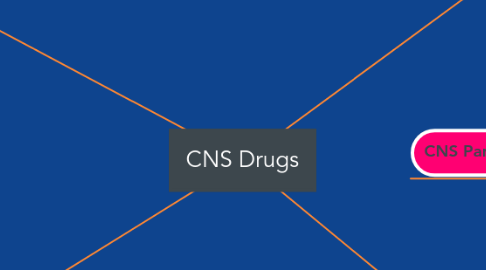
1. How to Navigate this Mind Map
1.1. Numbered Progression
1.2. This is placeholder Mind-Map. Begin reviewing this Map under CNS Pharmacology First, then use the Links to navigate to the individual Drug Therapeutic Classes
1.3. Note PT Relevance and how it is connected to Side-effects considerations
2. V. Side-Effects
2.1. Tolerance & Dependence
2.1.1. See PowerPoint for details (Drugs of Dependence & Abuse)
2.2. Side-effects are specific to drug class & individual drugs
3. VI. Relevance to Physical Therapy
3.1. EDUCATE
3.1.1. No Driving
3.1.2. No Operating Heavy Machivery
3.2. OBSERVE & ENSURE PATIENT SAFETY FROM UNINTENTIONAL HARM
3.2.1. Addictive & Habit-forming
3.2.1.1. Needs strong education to break dependence
3.2.2. Signs of Drug-Interactions (Additive Effects)
3.2.2.1. When taken inadvertently with other CNS Depressants
3.2.3. Signs of Drug Withdrawal
3.2.3.1. Seizure-like Symptoms
3.2.3.2. Ataxic Gait
3.2.3.2.1. May not be treated by Gait Aids - patient will still be at high risk for falls
3.2.3.3. Falls
3.3. REFER INDIVIDUAL THERAPEUTIC DRUG CLASSES for PT RELEVANCE
3.3.1. e.g.:: Anti-psychotics can cause extra-pyramidal side-effects
4. CNS Parts & Neurotransmitters
4.1. CNS
4.1.1. Brain
4.1.1.1. Cerebrum
4.1.1.1.1. Sensory, motor, intellectual & cognitive abilities
4.1.1.2. Basal Ganglia
4.1.1.2.1. Control of motor activities
4.1.1.3. Diencephalon
4.1.1.3.1. Thalmus
4.1.1.3.2. Hypothalamus
4.1.1.4. Mesencephalon
4.1.1.4.1. Midbrain
4.1.1.4.2. Brainstem
4.1.1.4.3. Reticular formation
4.1.1.5. Cerebellum
4.1.1.5.1. Plans & coordination of motor activity
4.1.1.5.2. Efference copy
4.1.1.5.3. Vestibular mechanisms for maintaining balance & posture
4.1.1.6. Limic system
4.1.1.6.1. Control of emotional & behavioral activity
4.1.2. Spinal cord
4.1.2.1. Gray matter
4.1.2.1.1. Synaptic connection between neurons
4.1.2.2. White matter
4.1.2.2.1. Myelinated axons of neurons
4.2. CNS Neurotransmitters
4.2.1. Acetylcholine
4.2.1.1. Both central & peripheral
4.2.1.2. Plays critical role in cognition & memory
4.2.1.3. Generally excitatory
4.2.2. Monoamines
4.2.2.1. Catecholamines
4.2.2.1.1. Dopamine
4.2.2.1.2. Norepinephrine
4.2.2.2. 5-hydroxytryptamine
4.2.2.2.1. Release by cells at the midline pons
4.2.2.2.2. Strong inhibitor of painful stimuli
4.2.3. Amino Acids
4.2.3.1. Excitatory
4.2.3.1.1. Aspartate
4.2.3.1.2. Glutamate
4.2.3.2. Inhibitory
4.2.3.2.1. Glycine
4.2.3.2.2. GABA
4.2.4. Peptides
4.2.4.1. Substance P
4.2.4.1.1. Excitatory
4.2.4.1.2. Transmits pain in spinal cord pathways
4.2.4.2. Opioids
4.2.4.2.1. Excitatory
4.2.4.2.2. Inhibit painful sensation & decrease central perception of pain
5. I. CNS Depressants
5.1. SEDATIVES, HYPNOTICS, ANXIOLYTICS
5.1.1. Class of drugs that cause a dose-dependent depression of the CNS functions -
5.1.1.1. Induces Sleep
5.1.1.2. Progresses to Unconsciousness with increasing dose
5.1.1.3. Relieves Anxiety
5.1.2. Drug Categories
5.1.2.1. Barbiturates
5.1.2.1.1. Largely Superseded in Use by Benzodiazepines. Some limited usage is in extreme Insomnia, Seizures not responsive to other agents, Induction of Anesthesia (see anesthetics mind-map), and in tension headaches (added w/Caffeine)
5.1.2.1.2. Drug Examples
5.1.2.2. Benzodiazepines
5.1.2.2.1. Drug Examples
5.1.2.2.2. Adverse Effects
5.1.2.3. Other Benzodiazepine-Like Substances (Z-Drugs)
5.1.2.3.1. Zolpidem (Ambien)
5.1.2.3.2. Zaleplon
5.1.2.3.3. Azapirones (Buspirone)
5.1.2.3.4. Selective Serotonin Reuptake Inhibitors (SSRIs) - Prototype Drug Venlafaxine (Expand to read Important info >>>)
5.1.2.3.5. Paraldehyde (Cyclic Ether) - Not common & Not Important for details for now
5.1.2.4. Alcohols
5.1.2.4.1. Behaves like Barbiturates in Dose-dependent Effects
5.1.2.5. Drugs that don't fit into above Categories
5.1.2.5.1. Methaqualone (Quaalude)
5.1.2.5.2. Ethchlorvynol (Placidyl)
5.1.2.5.3. Chloralhydrate (Noctec)
5.1.2.5.4. Mebrobamate (Miltown)
5.2. OPIOIDS
5.2.1. Pain
5.2.2. Cough Suppressant
5.2.3. Seizures
5.3. ANESTHETICS
5.3.1. Anesthesia
5.3.2. Pain Management
5.4. NEUROPSYCHIATRIC DRUGS
5.4.1. Schizoaffective Disorders
6. CNS Stimulants
6.1. Drugs to treat Affective (Mood) Disorders
6.1.1. Anti-Depressants (Depression)
6.1.1.1. SSRI's
6.1.1.1.1. Citalopram
6.1.1.1.2. Sertraline
6.1.1.1.3. Fluoxetine
6.1.1.2. SNRI's
6.1.1.2.1. Duloxetine Cymbalta
6.1.1.2.2. Venlafaxine
6.1.1.2.3. Duloxetine
6.1.1.3. Tricyclics
6.1.1.3.1. Block reuptake of amines at presynaptic terminal
6.1.1.3.2. Amitriptyline
6.1.1.3.3. Nortriptyline
6.1.1.4. MAOI's
6.1.1.4.1. Increase activity at amine synapses
6.1.1.4.2. Higher incidence of side effects
6.1.1.4.3. Phenelzine
6.1.1.5. A-typical antidepressants
6.1.1.5.1. Trazadone
6.1.1.5.2. Bupropion
6.1.2. Bipolar Disorder
6.1.2.1. Lithium
6.1.2.1.1. Primary drug to treat bipolar disorder
6.1.2.1.2. Narrow therapeutic index/not metabolized by the body
6.1.2.1.3. Prevents neuronal degeneration & sustain neuronal function
6.1.2.1.4. Side-effects:
6.2. Antipsychotic Drugs
6.2.1. Traditional antipsychotics
6.2.1.1. Associated w/ more side effects
6.2.1.2. Strong affinity for CNS dopamine
6.2.1.3. Examples:
6.2.1.3.1. Haloperiodol
6.2.1.3.2. Chlorpromazine
6.2.1.3.3. Fluphenazine
6.2.2. Atypical antipsychotics
6.2.2.1. Decreased risk of producing movement disorders & motor side effects
6.2.2.2. Do not block dopamine receptors as strong as traditional antipsychotic
6.2.2.3. Block 5-HT serotonin receptors in the limit system
6.2.2.4. Less effective than traditional drugs, but decreased chance for relapse
6.2.2.5. Examples:
6.2.2.5.1. Chlozapine
6.2.2.5.2. Quetiapine
6.2.2.5.3. Olazapine
6.2.2.5.4. Risperidone
6.2.3. Therapeutic concerns
6.2.3.1. Extra-pyramidial effects
6.2.3.2. Sedation
6.2.3.3. Cardiovascular complications
6.2.3.4. Obesity
6.2.3.5. Diabetes
6.2.3.6. High Cholesterol
6.2.3.7. Heat Intolerance
6.2.3.8. Sexual Dysfunction
6.3. Drug management of Parkinson's Disease
6.3.1. Levodopa
6.3.1.1. Converted to dopamine after crossing blood brain barrier
6.3.1.2. Best drug for resolving Parkinsonian s/s
6.3.1.3. Side Effects:
6.3.1.3.1. GI: nausea/vomiting
6.3.1.3.2. Cardiovascular: arrhythmias, postural hypotension
6.3.1.3.3. Dyskinesias
6.3.1.3.4. Behavioral: psychotic symptoms
6.3.1.3.5. Diminishing response over 3-4 years of continued use
6.3.1.3.6. Fluctuation in response - end-of-dose akinesia
6.3.2. Carbidopa
6.3.2.1. Given w/ Levodopa
6.3.2.2. Prevents premature conversion of levodopa to dopamine
6.3.3. Dopamine agonists
6.3.3.1. Stimulates dopamine receptors in the basal ganglia
6.3.3.2. May produce fewer side effects than levodopa
6.3.3.3. Early use may delay progression of Parkinson's disease
6.3.4. Anti-cholinergics
6.3.4.1. inhibits excessive acetylcholine influence
6.3.4.2. Use in Parkinson's disease limited by frequent side effects
6.3.5. Amantadine
6.3.5.1. Inhibits the effect of glutamate in the basal ganglia
6.3.5.2. Used in early/mild stage or added when levodopa loses effectiveness
6.3.6. MAO-B inhibitors
6.3.6.1. Inhibits the enzyme that breaks down dopamine in the basal ganglia
6.3.6.2. May improve s/s in early stages; long term may be neuroprotective
6.3.7. COMT inhibitors
6.3.7.1. Prevents breakdown of dopamine & allows more levodopa to reach the brain
6.3.7.2. Adjunct to levodopa/carbidopa; prolongs & improves effect of levodopa
6.3.8. Non-prescription
6.3.8.1. Vitamin E
6.3.8.2. Co-enzyme Q-10
